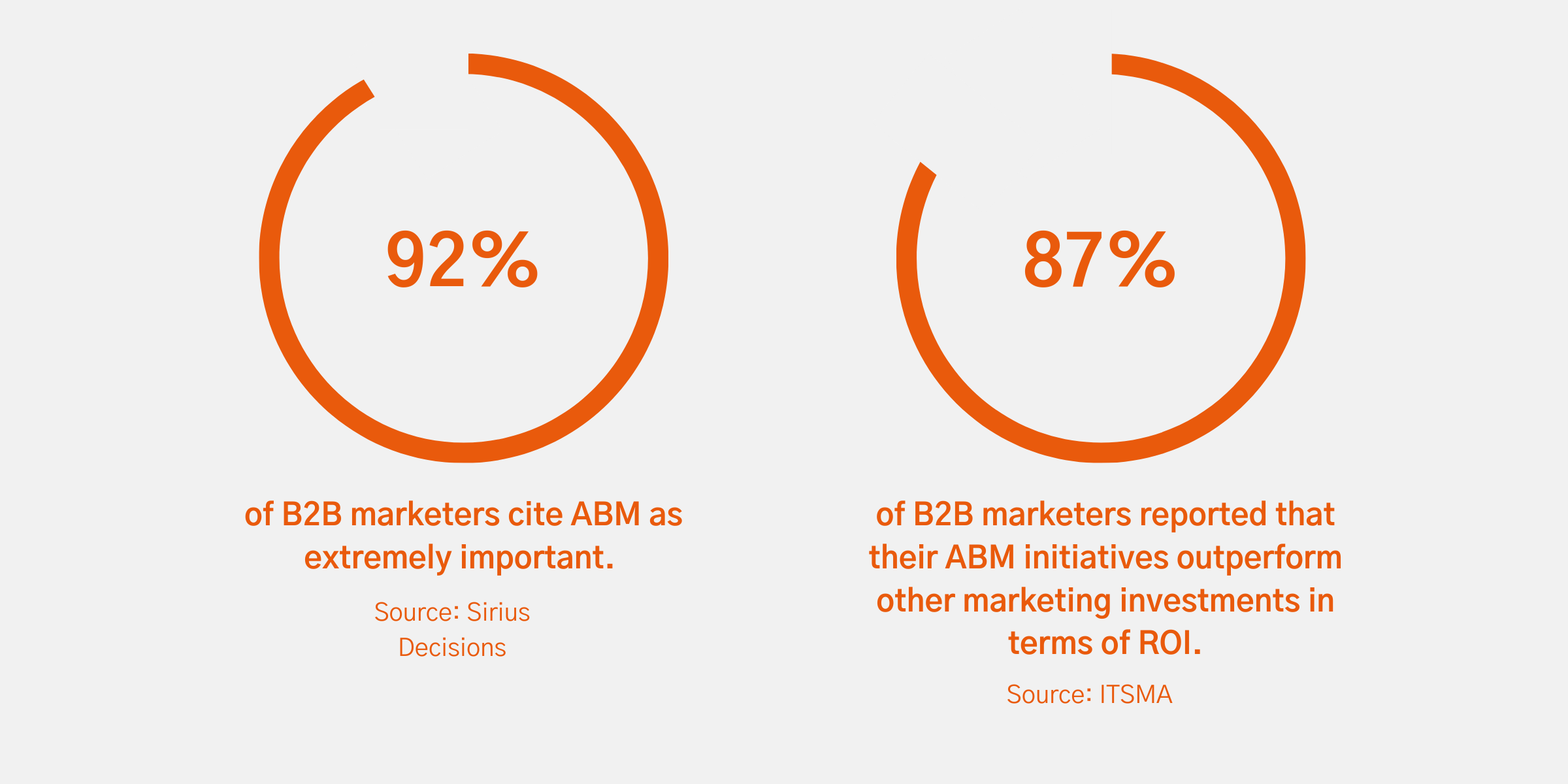Personalized, relevant and driving up to 208% increase in revenue, Account-based Marketing is rightly in the strategy toolkit of a growing league of B2B marketers.
ABM is all about orchestration.
With so many moving parts (profiling your ideal customers, selecting the right accounts, insights development, developing your value proposition, etc.), it is important to orchestrate your team, your resources and the wider organization to ensure the success of your ABM strategy.
So what do B2B marketers today need to know to build an effective and successful ABM program?
Alex Embling, CEO of strategicabm, recently joined Nettly’s Customer Acquisition podcast with Thorstein Nordby to share some ABM expert analysis and insights on what ABM is, what it isn't and where it's heading.
So let’s dive into the key takeaways from their conversation.
Defining Account-based Marketing
Everyone has different levels of understanding about what ABM is and what it means for them.
And while Account-based Marketing is one of the hottest topics around, there are a few misconceptions in the market about what it actually means to run an ABM program.
For instance, ABM is not:
- Solely a marketing strategy
- The best approach for all businesses and enterprises
- The same as personalized marketing
In order for ABM to be truly successful, you need business-wide buy-in; from Sales and Marketing, all the way to the C-suite.
And while personalization is a key element within an ABM strategy, it’s important to recognize the countless other ABM tactics that are needed to drive success.
“We define Account-based Marketing as a lens to target your target accounts” - Alex Embling, CEO of strategicabm
The key is to understand the difference between channel tactics and account-based strategies.
For instance, targeting a specific list of accounts and then running banner ads is not ABM. Nor is doing a direct mail campaign into a set of accounts.
These are just channel tactics.
Successful ABM is about having a deeper level of insight and data on an account and the people who are making the buying decisions within that account.
It's much more personalized than just targeting your messaging to a fictitious persona.
It’s about getting to know what is important to the account, not just from the job perspective, but also from the business' perspective and, sometimes, even at a personal level.
“You have to be clear about who it is you're trying to target. Making sure at the extreme level of ABM that you understand those accounts at a much deeper level than you would just running the focus demand gen program” - Thorstein Nordby, Nettly
Who should consider doing ABM?
According to Sirius Decisions, 92% of B2B marketers cite ABM as extremely important.
Meanwhile, 87% of B2B marketers surveyed by ITSMA reported that their ABM initiatives outperformed their other marketing investments in terms of ROI.

But does this mean ABM is suitable for all B2B businesses?
In simple terms...no.
There are a few main hurdles to overcome when starting with ABM; with one of the most obvious being having the right budget accessible.
Having the budget signed off and available to target a single account or a cluster of accounts at a much higher, more personalized level is integral.
Another factor that can make ABM challenging is a lack of sufficient insight and data on your target accounts.
Without the right data, your campaigns will lack the insight needed to truly personalize; resulting in promoting generic content into an account, hoping that it will resonate.
Quite simply, that is not ABM. And it certainly won’t drive the same quality results.
And then, of course, there's the importance of securing Sales and Marketing alignment, which is absolutely integral to support your program and drive those results.
In fact, when it comes to successful ABM, it's not only about ‘Sales and Marketing’.
To really succeed, it’s key to take the approach of ‘Account-based Everything!’
Every element of your business should be centered around the account in order to resonate.
There’s no question that ABM can be extremely effective - in the right hands!
If your business doesn’t have the solid foundations needed to pursue ABM - whether you’re lacking internal buy-in, data and insight, financial backing, or simply don’t have the level of personalization needed to cut through the noise - then your programs are destined to fail.
So where should you start?
The first step to implementing a strong ABM program should be securing business-wide buy-in.
After all, if you can’t get everyone in your business on the same page to start with, you’ll have no hope!
Then, it comes down to your Ideal Customer Profile (ICP). This has to be more than just a LinkedIn industry category and number of employees with a couple of job titles thrown in!
A true ICP has many, more nuanced data points to it.
For example, at strategicabm, our ideal clients are global B2B technology brands.
Branching off from this further, we have three tiers of accounts that we target:
- Big technology brands founded pre-2000. These tend to be companies with in-house marketing teams that are incredible at understanding their own market, but lack the modern digital marketing DNA that’s required for ABM. They’re lacking the technological resource. And that’s where we come in.
- Modern high-growth SaaS businesses. These companies tend to have very modern in-house teams but have a short-term knowledge issue with regard to getting into the enterprise space. Again, this is where strategicabm are able to help.
- And then we have our tier three accounts, who are usually just below Series A investment, high-growth businesses. Their marketing teams are much stronger, but they have a hunger to win big accounts, so they seek our help.
This level of detail is where your really important information sits. You need that really structured, defined ICP to guide you on the rest of your ABM journey.
Once you have that, it's about product market fit and understanding what factors start a sales conversation - what's the right level of personalization to really engage that account?
The key is to combine a really strong value proposition, with cutting-edge data and insights and then it will manifest itself into an incredible piece of content that really engages with key decision-makers at a personal level.
When all those elements combine, that’s when you’ll start to see those really high-value sales conversations come together!
What do you need in your ABM tech stack?
Technology is a big part of ABM. Without it, it would be practically impossible to gain the insight needed to personalize and customize campaigns.
Of course, modern ABM is still relatively new, and the use of technology highlights where it differs from other strategies, such as key account marketing.
The concept of treating accounts as a market of one isn't new. But what is, is the volume of data and insight that is available on accounts and buyers - even before that first point of engagement.
Different technologies each play an important part in enabling that flow of insight; from your CRM all the way through to third party data sources.
And that’s why having the right tech stack in place to support your ABM strategy enables a more interlinked, streamlined program - from start to finish.
So what kind of platforms should an aspiring ABM team invest in?
- Intent data platforms are a godsend for ABM programs. Platforms like Cyance give access to invaluable insights and data about your accounts activity and position in the market.
- Reporting software like Databox allows for a holistic, cross-departmental view of data and insights that is accessible for everyone in your organization.
- Social media platforms such as LinkedIn. Sales and Marketing are becoming increasingly personalized - and social advocacy and social selling play an important part in that. Today, it’s vital that your teams build an approachable, informative social presence wherever your buyers spend their time.
With the right tech supporting your ABM efforts, you’ll quickly find that the rest of your program begins to fall into place.
Of course, that’s not to say that the more tech you invest in, the more likely you’ll be to succeed in ABM. In fact, it’s often the opposite.
The right technology is no substitute for coherent planning ahead of launching your campaign. But it sure will make managing, actioning and running your program that much easier!
How would you go about implementing an Account-based Marketing strategy?
1. Know your product market fit
Before you get stuck into building your ABM program, make sure you have a solid understanding of who you are as a business, and who you are aiming to reach.
2. Define your ICP
Know who to go after (and importantly why). Check out this ABM in the House webinar where we talk about this in more detail.
3. Build a strong value proposition
Once those foundations are in place, the focus should be on building a really strong value proposition that resonates with your target account.
This will ultimately inform all of the content and creative work that goes into your campaigns, so it’s essential that your value proposition demonstrates the message that you want to put out into the world.
But perhaps most importantly, when it comes to creative, you've got to think outside of the box and be innovative to engage high-value decision makers. Otherwise, you may be tuned out.
To break through the noise you need:
- really strong insight into your accounts, and
- a solid value proposition.
One of the more common problems that organizations face with ABM is where they have promoted generic content to their target accounts - so are struggling to stand out.
The key to success and stand-out campaigns is to personalize. And that's why it’s wise to reduce the volume to no more than 15 accounts, that you can focus on in-depth.
Just by definition, it’s very difficult to scale meaningful ABM personalization. And truthfully, just inserting someone's first name and a company into an email isn't meaningful enough.
You need to get to the heart of the decision makers within an account. So by limiting your scale to 15 accounts or less, you can really hone in on the quality over quantity.
How can you measure ABM success?
The key to measuring the success of your ABM program lies in the three Rs: Reputation, Relationships and Revenue.
Of course, these are fairly self-explanatory. Just ask yourself the following questions:
- Reputation: How well are you penetrating the account? Has your brand awareness increased within the account?
- Relationship: Are you building a relationship with the account? Have you started a meaningful conversation with them?
- Revenue: Arguably the most important end metric!
In order to get the most accurate view of the success of your ABM efforts, all three of these metrics need to be taken into account.
After all, you can’t close revenue until you’ve developed relationships, and built reputation and trust within the account.
What next?
Like any marketing strategy, ABM is continually evolving; and we see new technologies, approaches and tactics driving programs further almost weekly.
But, the very core elements for success remain the same.
With the right buy-in, insight, and refined approach to account selection and insight, ABM enables a resilient, human, and personalized approach to Marketing and Sales; that will reach and resonate with the exact right audience for your brand.



